Updated: 07-Apr-2024
By 1914, Siemens had obtained patents for radial rotary aviation engines to equip the airplanes it produced through the Schuckert division. (GR 7K and 9C).
-In 1917, a 110 CV Siemens rotary powered the Siemens Schuckert D1 aircraft, as the Siemens Sh1 engine. The Sh1A gave 120 CV.
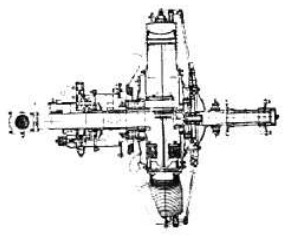
“Siemens Sh III”
-In 1918, the Pfalz DR1 and Albatros D.XI aircraft were powered by the 11-cylinder, 160 CV rotary engine. The engine was known as the Sh III and was a bi-rotary. This engine appeared in 1917. Sometimes written as Sh-3.

“Front elevation of Sh III”
-Being a bi-rotary engine, it had a gear system that made the motor rotate in one direction and the propeller in the opposite direction. This engine reached 200 CV in its different versions and culminated at 220 CV.
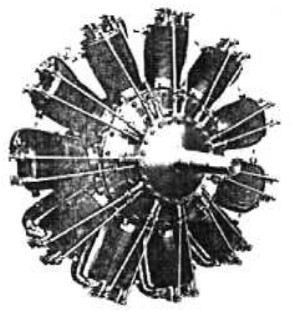
“Siemens Sh III”
-The internal dimensions of the cylinder were: 124 mm diameter by 140 mm piston stroke. The 11 cylinders were already an exception, although several manufacturers were building them.
-At the Munich Museum there is a beautiful example of an Sh III.
-Siemens was one of the few brands that made 11-cylinder radial rotary engines. It gave 200 CV.
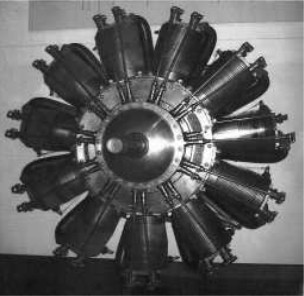
“Sh III photo”
-The cylinders rotated in one direction at 1,800 rpm while the propeller rotated in the opposite direction at 900 rpm.
-Since the propeller rotates at 900 rpm, it could use more efficient propellers, with less gyroscopic effect, typical of these engines.
-The rotation of the propeller and the cylinders almost counteracted each other.
-As we will see in the next chapter, a variant of this engine was called Siemens-Schuckert (see), which, from what is known, was the structures manufacturing division. However, on many occasions they appear with that name.
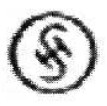
“Siemens-Halske logo”
-The initials “Sh” correspond to Siemens & Halske, the Siemens Aviation Engine Division.
-It is known that Siemens had designs that, when made by Halske, changed their reference. Thus the S5 was made as Sh13. The S7 as Sh14 and the S9 as Sh12.
-Here and before continuing, we would like to mention a couple of engines that break the line of the brand's radials:
-One was the horizontally-opposed, 2-cylinder engine resulting from the repression of the Treaty of Versailles. This engine is from 1924 and is known as the Siemens-Halske Superior, giving 16 CV at 1,500 rpm.
-The other was a two-cylinder Vee engine that is shown in the below illustration installed on a B. Hentzen II aircraft.
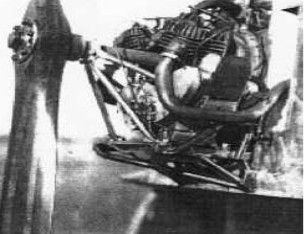
“Siemens V-2”
-Returning to the radial engines, they were already made fixed instead of rotary.
-The first radial to appear was the Sh 4, in 1921. This was a 5-cylinder with a bore and stroke of 100 x 120 mm, from this model on up to the Sh 12.
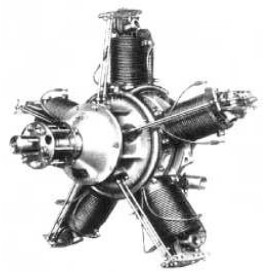
“Siemens Halske Sh 4”
-It started with 55 CV. It gave 62 CV at 1,600 rpm and maximum continuous power of 58 CV.
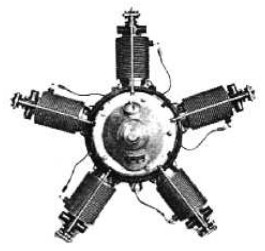
“Sh-4, front view”
-The Sh 5, from 1923, had 7 cylinders, with the same displacement as the Sh 4, but it gave 85 CV at 1,600 rpm, and maximum continuous 76 CV at 1,500 rpm.
-We can show a Sh.5 that is missing in the text of the first edition.
-It is obtained at a technical museum in Terrassa. (BCN)

“Siemens & Halske Sh.5”
-The Sh 6, with 9 cylinders, also from 1923, gave 110 CV at 1,600 rpm.
-We move on to the next one, which is the 70 CV Sh 10 with its five radial cylinders.
-We can see the intake tubes with smooth curves, that is, “harmonic”.

“Sh-10”
-The Sh 11, a version of the previous one with 7 cylinders, gave 96 CV at 1,750 rpm.
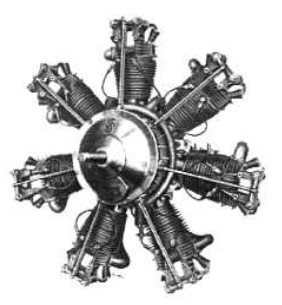
“Siemens Sh 11”
-The Sh 12 had 9 cylinders and like the previous two, it was from 1925. The maximum power was 125 CV.
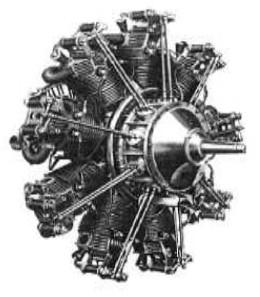
“Sh 12”
-Other views of this engine are offered, included with the exhaust manifold.
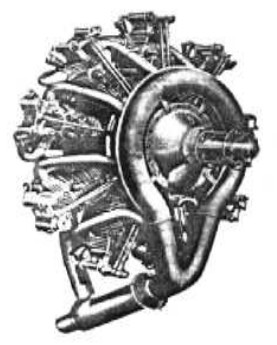
“Siemens Sh 12, with exhaust manifold”
-But the most curious thing is that the Sh 12 was also offered with the instruments and controls in a panel and a structure that included the bench and the firewall.

“Sh 12, on the left front side”

“Sh 12, in full”
-Now we go on to deal with the Sh 13 and Sh 13A, which were 5-cylinder radial engines from 1928. They had 105 mm bore and 120 mm stroke, giving 88 CV at 1,900 rpm.

“Sh 13”
-Around 1930 the Sh 13 gave way to the Sh 13A, also with 5 radial cylinders.

“Sh 13A”
-To break a little with so much data, we will mention that the name of Siemens & Halske is due to the founders Werner von Siemens and his partner, a mechanical expert named Johann Georg Halske. The company grew and two Siemens brothers became part of the company. Charles William Siemens represented the company in Great Britain and Carl Heinrich von Siemens represented the company in Russia.
-At first the company was manufacturing telegraph equipment, electric motors and generators. It built the world's first electric streetcar line. As from WWI Siemens started to built aircraft engines,

“Ch. W. Siemens”
-Siemens & Halske was founded at the end of the 19th century, in 1897, but the company with Siemens began in 1847 dedicated to telegraphy, etc.
-In 1903 the Siemens-Schuckert Werke was founded.
-After this short parenthesis, we continue with another engine that was built under license, the Bristol Jupiter that gave 450/500 CV, and was built around 1927.

Siemens-Halske, Jupiter under Bristol license
-Specifically they were a version of the Jupiter VI, with 9 air-cooled cylinders. Was it the Sh 22?
-In 1929, these engines were used in a version of the large multi-engine seaplane (12 engines) from Dornier, the Do-X.

“Do-X with S&H Jupiter engines”
-Following the order we arrive at Sh 14 and Sh 14A.
It was important because it was widely used on various aircraft. This was in 1931. They gave 140/160 CV.

“Sh 14”
-There is a certain confusion that has not yet been clarified by the author, both in the 14 and 14A, since photographs are observed with and without rocker covers, depending on the publication and the publisher.
-Thus we have Sh 14 with and without covers and Sh 14A, the same.
-If we see that the previous models do not have them, it would be logical to believe that the 14 does not have them and the 14A does.

“Sh 14A at the Munich Museum”
-But as we see, in Germany itself, the Sh 14A does not have them.
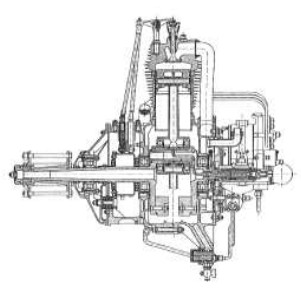
“Sh 14A”
-The Siemens & Halske Aviation Engine Division factory was located in Berlin-Spandau.
-To confirm what was previously said, we provide two photographs of both engines with rocker covers, according to the information that has been transmitted to us.
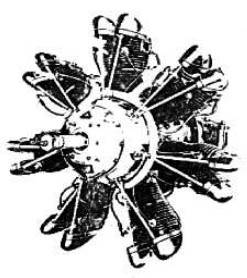
“Siemens & Halske, Sh 14”

“Siemens & Halske, Sh 14A”
-The Sh 14 had a unitary displacement with the following dimensions: 108 mm bore by 120 mm stroke, and its 160 CV was obtained at 2,200 rpm.
-The Sh 14 on the German Focke-Achgelis Fw-61 helicopter gave 160 CV.
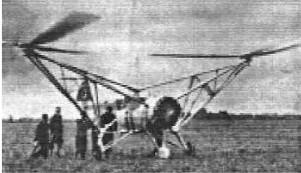
“Fw-61with the Sh 14 engine”
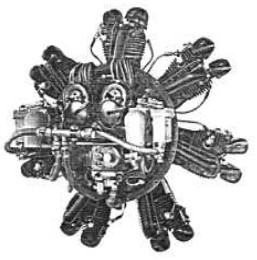
“Sh 14A rear view”
-The next known engine of the brand is the Sh 20, and the Sh 20/U version as well. They are from the years 1927 and onwards.
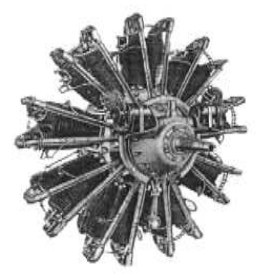
“Sh 20”
-It had nine radial cylinders ad gave 550/600 CV. The U variant gave 540 CV. These powers were obtained by considerably increasing the cylinder size of the previous models (except the Jupiter).
-The bore was already 154 mm and the stroke was 160 mm. The magnetos were visibly mounted on the front.
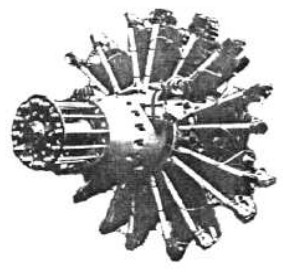
“Sh 20/U”
-The Sh 21 had seven cylinders and gave between 420 and 450 CV.

“Sh 21”
-It is followed by Sh 22 and Sh 22B, the first one from 1929. This engine is said to be a Bristol Jupiter engine, built under license.
-It remains to be verified whether it was the Jupiter mentioned above that went on the Do-X with precisely this reference.
-The truth is that the 22B was the SAM 322B with 9 cylinders giving 650 CV (see SAM).
-It is worth clarifying here that Siemens & Halske AG was a subsidiary of Siemens Apparate und Maschinen GmbH of Germany.
-In 1936 Siemens & Halske was reorganized by the parent company as Brandenburgische Motorenwerke GmbH.
-This company manufactured engines during the Second World War under the name Bramo until it became BMW. See.
-Manufactured by SAM, the H2 version gave 715 CV at 2,330 rpm. It was geared and had a hu for the typically German WWII propeller. It had nine radial cylinders with two exhaust valves and one intake valve per cylinder.

“SAM 322 H2”
-This engine was used in the Spanish Civil War on the Heinkel “Pava” rebel planes and its sound was characteristic.
-In 1938 the Bramo 323 “Fafnir” was produced, which would later be manufactured by BMW. It had nine radial cylinders and gave 1,000 CV at 2,500 rpm. maximum power.
-Here we clarify that Bramo comes from the contraction of BRAndenburgische MOtorenwerke.

“Bramo 323, Fafnir”
-Throughout its history, Siemens made experimental and test engines, little known such as the SL or the R-12 with four cylinders in X, diesel and supercharged by a huge vane pump (compared to the size of the engine).
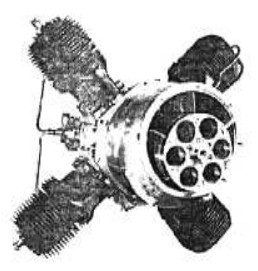
“Siemens R-12, 80 CV”
Part II
We now begin a complementary story to that of the main text, with recent information obtained from visits to museums of our collaborators. Starting with a factory logo taken from a manual.

“Siemens logo”

“Siemens & Halske ad”
-An engine that does not appear in the main text is the Sh-1 of which we show an image below. Siemens & Halske began making aircraft engines in Berlin in 1912.
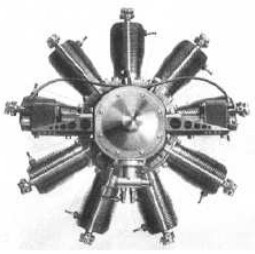
“Sh-1 from 1917,100 CV”
-In 1918, two study lines were made to participate in the Kaiser prize contest. The first one was a double Sh-1, with 18 cylinders and on the second one the Sh-3 (Sh-III). The double Sh-1, considered the Sh-2, had 18 cylinders in two rows and gave 110 CV. The Sh-3 reached 160 CV.

“18-cylinder Siemens, possible Sh-2”
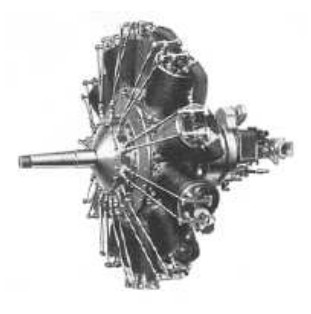
“Sh-3 11-cylinder engine”

“Sh-IIIa engine, 160 CV and from 1918”
-Manufacturing after the WWI war began around 1921 with the Sh-4 of only 55 CV. The 77 CV Sh-5 and the Sh-6. As stated in the main text, from 1925 onwards the new engines would be others based on previous designs. Starting with the Sh-10.
-Thus the Sh-5 would be the Sh-13. The Sh-7 would be the Sh-14, etc.

“Sh-4, 55 CV”
-As from 1925 the Sh-10, Sh-11, Sh-12 appeared. The Sh-13 is from 1926, the same as the Jupiter manufactured under license from Bristol.

“The Sh-12 with 9 cylinders giving 108/125 CV”
-In 1926 the Sh-13a and Sh-14 came out. This year the factory was named Siemens-Flugmotorenbau. The Sh-14a of 1929 would also be the 9-314.
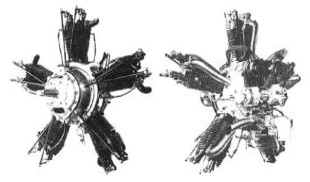
“The Sh-13a engine”
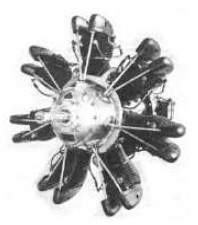
“Siemens Sh-14a”
-In 1933-34 Siemens & Halske became a subsidiary of Siemens Apparate und Maschinen (SAM, see) and the Sh-22 would be known as SAM-22 and later Bramo 322H.
-In 1936 it became Branderburgische Motorenwerke GmbH (Bramo) and finally in 1939 it would be absorbed by BMW Flugmotorenwerke Branderburg GmbH.
-The Sh-23 would be the new Bramo 323 “Fafnir”, a notable engine of which there were series such as the A, B and J with 900 CV.
-There were the C, D, E, M, P and T models that gave 1,000 CV and the R with 1,200 CV.
-The Bramo 301 was developed from the 323 (Twin Fafnir?) for a possible helicopter.
-The Sh-25 that gave 175 CV would be the Bramo 325 derived from the Sh-14a.
-The Sh-28 that gave 300 CV would give way to the Bramo 328.
-And the Sh-29 that gave 1,500 CV like Bramo 329, was halfway finished.
Part III
In 1918, among the several patents that the brand obtained, there were some very interesting ones for coupling two rotary motors to drive - and add - one or two propellers.

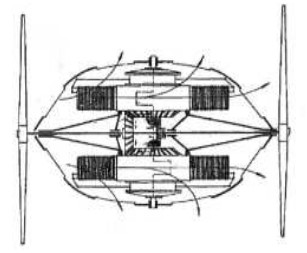
“Two coupling possibilities for Siemens motors”
From Appendix 7: A better view of the 11-cylinder Sh-III.
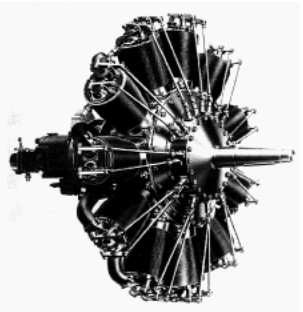

“The ShIII and rear part” (PeT-fmr)
-The magneto in the foreground and the carburetor at the end of the shaft do not control the engine speed, this is done - as in almost all rotary engines - by cutting off the ignition.
From Appendix 9: here we can see a Siemens Halske Sh-III, with 11 birotary cylinders at the Vienna museum.

“Siemens-Halske Sh-III” (E-V)
-From the main text we know that it is birotary due to the fact that the cylinders rotate in one direction at 1,800 rpm and the propeller rotates in the opposite direction at 900 rpm.
-The reason is to concentrate more force on the propeller and also counteract the gyroscopic effect of the engine, in part important. See the Rototo chapter on this topic.

“The Sh-III from behind”
-In the above photo you can clearly distinguish the part that is fixed to the structure of the aircraft and the rotating mobile part of the engine.
-The author would like to be in the presence of this engine to try to move it, at least make a gesture with the cylinders to see the propeller hub as he does in the opposite direction.
-But the situation is that the output shaft is flanged to the support so this verification is more difficult to carry out if it is not with the collaboration of the Museum.
-To export to the USA, Siemens & Halske AG was established towards the end of the 1920's (1929 is the date of the news).
-The 5-cylinder Sh-13 engines were called “Yankee 5”, the 7-cylinder Sh-14, the “Yankee 7”, and the 9-cylinder Sh-12, the “Yankee 9”.
From Appendix 12: From an aeronautical magazine published between 1909 and 1945, we have illustrations of the Siemens & Halske engine brand.
-Starting with an advertisement and followed by diagrams and photographs of different models, including the Sh18 that does not appear in the main text.

“Ad of the time”
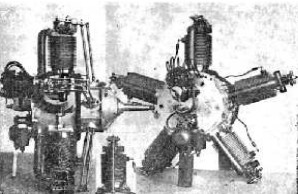
“Siemens Sh.4”

“Sh.14A and A4, schematic drawing”
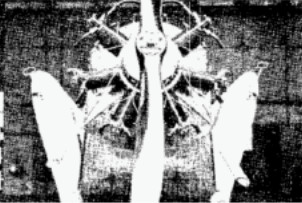
“Siemens Sh.18”
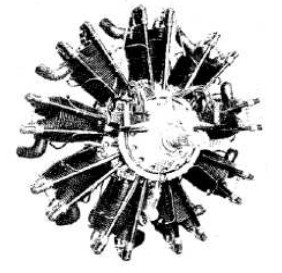
“Siemens Sh.20”
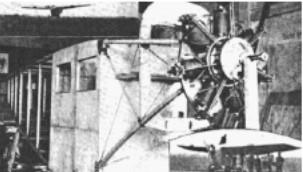
“Installation of a Siemens in an aircraft cell”
Engines of SIEMENS & HALSKE AG
Model: 2V
Arquitecture:
Cooling:
Total Displacement:
Bore / Stroke: x
Power:
Weight:
Model: 314
Arquitecture:
Cooling:
Total Displacement:
Bore / Stroke: x
Power:
Weight:
Model: Jupiter (Lic. 1927)
Arquitecture:
Cooling:
Total Displacement:
Bore / Stroke: x
Power:
Weight:
Model: Le-Rhone 9C (Lic.)
Arquitecture:
Cooling:
Total Displacement:
Bore / Stroke: x
Power:
Weight:
Model: R-12, 4 cyl. X-shape
Arquitecture:
Cooling:
Total Displacement:
Bore / Stroke: x
Power:
Weight:
Model: SAM 22B
Arquitecture:
Cooling:
Total Displacement:
Bore / Stroke: x
Power:
Weight:
Model: Sh-10
Arquitecture:
Cooling:
Total Displacement:
Bore / Stroke: x
Power:
Weight:
Model: Sh-11
Arquitecture:
Cooling:
Total Displacement:
Bore / Stroke: x
Power:
Weight:
Model: Sh-12
Arquitecture:
Cooling:
Total Displacement:
Bore / Stroke: x
Power:
Weight:
Model: Sh-13
Arquitecture:
Cooling:
Total Displacement:
Bore / Stroke: x
Power:
Weight:
Model: Sh-14
Arquitecture:
Cooling:
Total Displacement:
Bore / Stroke: x
Power:
Weight:
Model: Sh-15
Arquitecture:
Cooling:
Total Displacement:
Bore / Stroke: x
Power:
Weight:
Model: Sh-18
Arquitecture:
Cooling:
Total Displacement:
Bore / Stroke: x
Power:
Weight:
Model: Sh-20
Arquitecture:
Cooling:
Total Displacement:
Bore / Stroke: x
Power:
Weight:
Model: Sh-21
Arquitecture:
Cooling:
Total Displacement:
Bore / Stroke: x
Power:
Weight:
Model: Sh-22 (322)
Arquitecture:
Cooling:
Total Displacement:
Bore / Stroke:
Power:
Weight:
Model: Sh-23 (323)
Arquitecture:
Cooling:
Total Displacement:
Bore / Stroke:
Power:
Weight:
Model: Sh-25
Arquitecture:
Cooling:
Total Displacement:
Bore / Stroke: x
Power:
Weight:
Model: Sh-28
Arquitecture:
Cooling:
Total Displacement:
Bore / Stroke: x
Power:
Weight:
Model: Sh-29
Arquitecture:
Cooling:
Total Displacement:
Bore / Stroke: x
Power:
Weight:
Model: Sh-4
Arquitecture:
Cooling:
Total Displacement:
Bore / Stroke: x
Power:
Weight:
Model: Sh-5
Arquitecture:
Cooling:
Total Displacement:
Bore / Stroke: x
Power:
Weight:
Model: Sh-6
Arquitecture:
Cooling:
Total Displacement:
Bore / Stroke: x
Power:
Weight:
Model: Sh-I
Arquitecture:
Cooling:
Total Displacement:
Bore / Stroke: x
Power:
Weight:
Model: Sh-II
Arquitecture:
Cooling:
Total Displacement:
Bore / Stroke: x
Power:
Weight:
Model: Sh-III
Arquitecture:
Cooling:
Total Displacement:
Bore / Stroke: x
Power:
Weight:
Model: Yankee 5 (Sh13)
Arquitecture:
Cooling:
Total Displacement:
Bore / Stroke: x
Power:
Weight:
Model: Yankee 7 (Sh14)
Arquitecture:
Cooling:
Total Displacement:
Bore / Stroke: x
Power:
Weight:
Model: Yankee 9 (Sh12)
Arquitecture:
Cooling:
Total Displacement:
Bore / Stroke: x
Power:
Weight:


